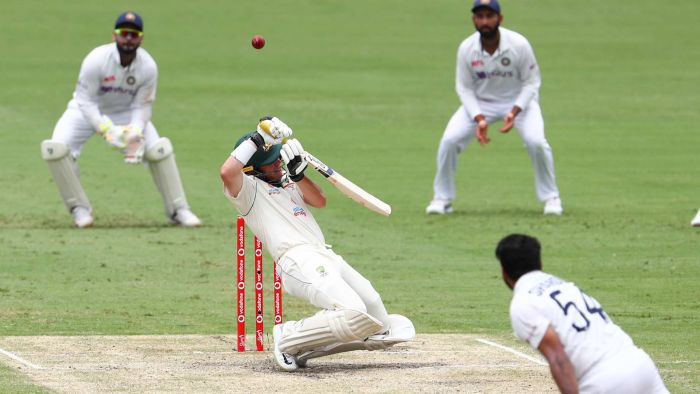At 3:00pm Brisbane time on Monday, eight members of the Gabba ground staff guarded the perimeter of the pitch covers.
Rain was still falling, but lightly enough that a few of the milling figures adopted the familiar stooped pose, scrolling away on smartphones.
There wasn’t much to do other than check the weather radar and figure out what everyone was saying about an Australian declaration.
The home side led by 276 runs at that point.
Whether it factored into his decision or not, Tim Paine had just witnessed firsthand the unpredictability of the fourth-day surface.
Earlier, there had been murmurs of discontent as Cameron Green took 90 deliveries to eke out 37.
Perhaps they weren’t the quick runs the doctor ordered, but whom among his critics would have happily faced up to 140 kilometre per hour deliveries that reached the batsman at shin height as often as they leapt off the surface towards the ribcage?
Paine has an uncanny ability to win coin tosses but he isn’t clairvoyant, and he’s learned not to underestimate this Indian outfit.
Those pointing out that no team has successfully chased more than 236 in the fourth innings of a Brisbane Test weren’t standing behind the stumps on day five in Sydney — nor, indeed, the latter stages on day three of this game, when a tailender made Australia’s vaunted bowling attack look pedestrian.
Half an hour later, Pat Cummins and Mitchell Starc returned to the crease and Australia batted on.
Mohammed Siraj continued to bowl like he owned the place — which was a kind of triumph itself, no matter how this game pans out — and ended up with his maiden five-wicket haul in Tests.
Australia’s lead was 327 by the time the last wicket fell, and the widening cracks were sending some deliveries at right angles.
That India remains a puncher’s chance of preventing Australian victory is a stunning achievement.
Australia’s bowlers entered this game with 1033 wickets between them, India just 11.
Taking 20 wasn’t easy, but India’s attack did it on Monday with the swagger of veterans.
Thanks to the obligatory injury to Navdeep Saini, Siraj and Shardul Thakur had to do it all themselves and almost did, taking nine second-innings wickets between them.
Shardul’s match analysis so far is seven wickets and a game-changing 67 with the bat.
If things go wrong for India on day five, Siraj will still leave a hero.
Perhaps the pampered tennis stars who’ve been griping about their lockdown experiences could read his story for a dose of perspective, or imagine Josh Hazlewood, Pat Cummins and Mitchell Starc firing Kookaburras into their ribs.




Australia can still take away some positives from a frustrating day.
Pressed into action following a mini-collapse, Green was not visibly daunted by the high-pressure scenario.
Composure has been the hallmark of his debut Test series, and unlike a few of his more senior teammates, he accepts his fate once beaten.
Steve Smith, on the other hand, reviewed a dismissal so clear cut you wonder whether he’ll become the first man to call for DRS when he’s clean bowled.
Marcus Harris and David Warner made the fluent starts Australia has lacked from its openers all summer, although there will only be a place for one of them once Will Pucovski’s shoulder heals.
Marnus Labuschagne could be said to have batted selflessly, moving the game on according to tactical requirements and sacrificing his wicket in the process.
Pat Cummins finally released his shackles.
Yet serious problems remain.




What India has exploited all summer — and with an ever-changing line-up, meaning that the trend lies within the home side — is Australia’s frequent and damaging lapses into negative momentum.
The cliche that ‘one brings two’ has held all summer.
On Monday, Australia had these patches again: the first two wickets fell for two runs in the space of six deliveries; three and four fell for nothing within four deliveries.
In the first innings, 3-4 in 14 balls was another sequence.
Recently, the principle applies equally to the bowlers, who are battle-weary and sore, it’s true, but have repeatedly found a holding pattern.
If they bowl as short in the second innings as they did in the first, and spend similarly prolonged periods ignoring the fundamental principle of attacking the stumps, rain will not be their only obstacle on day five.
Perhaps it will be a finale for the more settled members of India’s team.
One of the most arresting sights of this tour occurred three weeks ago in Melbourne, when a member of the Indian coaching staff faced the wicketkeeper Rishabh Pant and gently hit balls into his gloves.
It couldn’t be called a training drill, really, because it didn’t replicate anything that would happen in a game.
Not even a B-team junior would bother with a routine so basic.
You watched it and thought, “no wonder this guy can’t catch a cold”.
On Monday, Matthew Wade strangled his first delivery down the leg side and provided Pant with one of his toughest catching chances all summer.
He needed to dive at full stretch, reel it in safely and hold tight as he crashed into the ground.
None of those things are Pant’s strengths.
But against the laws of probability, Pant caught it, yet another defiance of the odds by the team that will not die. Would you bet against them?







